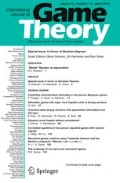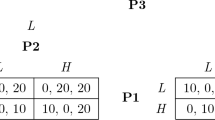Abstract
I study games with countably many players, each of whom has finitely many pure strategies. The following are constructed: (i) a game that has a strong \(\epsilon \) equilibrium for all \(\epsilon >0\) but does not have a Nash equilibrium, and (ii) a symmetric game in which Nash equilibria exist, but all of them are asymmetric. Some additional results about infinite symmetric games are also derived.
Similar content being viewed by others
Notes
A more detailed discussion on the merits of the countable player set model can be found in Voorneveld (2010).
See Billingsley (1995), p. 287.
In Flesch et al. (2014) a discussion about this reasoning appears in the context of multi-stage games.
Solan and Vielle use the term “perfect \(\epsilon \) equilibrium.”
The proof of this fact is essentially the same as the proof of Nash equilibrium non-existence in this game.
This is a direct consequence of the Borel–Cantelli Lemma; see Billingsley (1995), pp. 59–60.
A clear case in point is provided by models of intergenerational equity [see, e.g., Asheim (2010)], in which there are infinitely many generations, and the central issue is how to treat them fairly.
Relatedly, there is a significant difference between invariance under finite and arbitrary permutations in the intergenerational equity setting; see Lauwers (1998).
To the best of my knowledge, a proof of this result has not been previously published; however, since it boils down to a straightforward application of Kakutani’s fixed-point theorem, I choose not to include it in the paper.
A G such that N is finite is called a finite game.
References
Asheim GB (2010) Intergenerational equity. Ann Rev Econ 2:197–222
Azrieli Y, Shmaya E (2013) Lipschitz games. Math Oper Res 38:350–357
Billingsley P (1995) Probability and measure, 3rd edn. Wiley, New York
Fey M (2012) Symmetric games with only asymmetric equilibria. Games Econ Behav 75:424–427
Flesch J, Kuipers J, Mashiah-Yaakovi A, Schoenmakers G, Shmaya E, Solan E, Vrieze K (2014) Non-existence of subgame-perfect \(\varepsilon \)-equilibrium in perfect information games with infinite horizon. Int J Game Theory 43:945–951
Harsanyi JC (1973) Games with randomly disturbed payoffs: a new rationale for mixed-strategy equilibrium points. Int J Game Theory 2:1–23
Kalai E (2004) Large robust games. Econometrica 72:1631–1665
Khan AM, Sun Y (2002) Non-cooperative games with many players. In: Aumann RJ, Hart S (eds) Handbook of Game Theory, vol 3. North-Holland, Amsterdam, pp 1761–1808
Lauwers L (1998) Intertemporal objective functions: strong Pareto versus anonymity. Math Soc Sci 35:37–55
Moulin H (1986) Game theory for the social sciences. NYU Press, New York
Nash JF (1951) Non-cooperative games. Ann Math 54:286–295
Peleg B (1969) Equilibrium points for games with infinitely many players. J Lond Math Soc 44:292–294
Radner R (1980) Collusive behavior in non-cooperative epsilon-equilibria of oligopolies with long but finite lives. J Econ Theory 22:136–154
Salonen H (2010) On the existence of Nash equilibria in large games. Int J Game Theory 39:351–357
Solan E, Vielle N (2001) Quitting games. Math Oper Res 26:265–285
Voorneveld M (2010) The possibility of impossible stairways: tail event and countable player sets. Games Econ Behav 68:403–410
Acknowledgments
Insightful comments by Igal Milchtaich, Ron Peretz, Amnon Schreiber, Igor Ulanovsky, and anonymous referees are gratefully acknowledged. A special thanks goes to an Associate Editor, whose comments resulted in a serious improvement of the paper.
Author information
Authors and Affiliations
Corresponding author
Rights and permissions
About this article
Cite this article
Rachmilevitch, S. Symmetry and approximate equilibria in games with countably many players. Int J Game Theory 45, 709–717 (2016). https://doi.org/10.1007/s00182-015-0479-5
Accepted:
Published:
Issue Date:
DOI: https://doi.org/10.1007/s00182-015-0479-5




